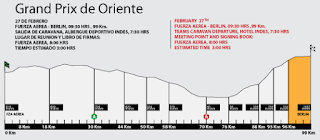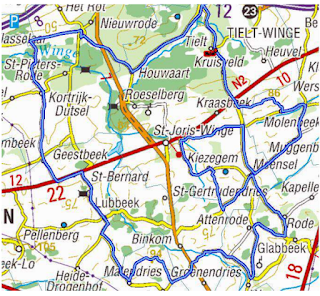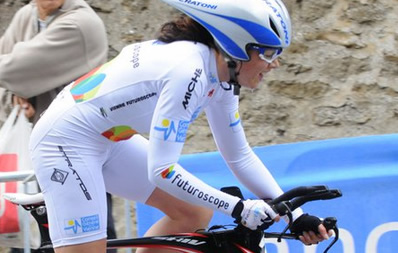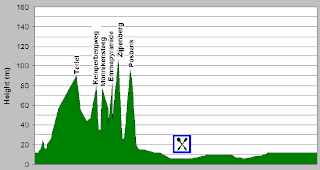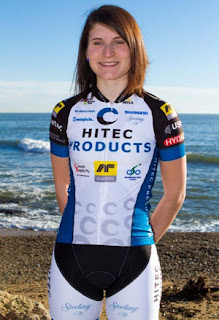03 - 07.04.2013Official SiteNetherlands, Road Race, 5 stages, 543.6km (Elite), 214.4km (Juniors)UCI 2.2![Image credit: Velocio Sports/Specialized-Lululemon http://velociosports.com/team/ina-yoko-teutenberg/]() |
| 2012 winner Ina-Yoko Teutenberg |
Last year the Energiewacht Tour, previously not especially well known outside the Netherlands, finally got the attention it deserves thanks to a first rate start list and a beautiful parcours that encouraged attacks on almost every kilometre leading to some top-notch racing - for many fans, including this one, it was one of the highlights of the 2012 women's cycling calendar. The newly-revealed 2013 parcours looks set to offer more of the same - it's as flat as last year, so expect plenty of high-speed stage finishes in what promises to be the best edition of the race yet.
As was the case for the first time last year, the race will once again run over five days; this year there'll also be a three-stage race for women in the Junior category, to run on the final three days of the Elite event and using part of the Elite parcours. This is excellent news in times when even races as big as the Giro Donne have faced uncertainties and provides evidence that, given sufficient determination on the part of advertisers and faith from sponsors, women's cycling can survive and even grow in a difficult economic climate. Race organisers applied for and were granted UCI 2.1 status for the Junior event;
25 teams - including national squads from both Great Britain and Wales - have signed up.
The StagesStage 1 (03.04.2013)![Image credit: Energiewacht Tour http://www.energiewachttour.nl/]() |
| Stage 1 - click to enlarge |
The Elite race began on the 3rd of April at Oldambt with Stage 1
, started by local mayor Pieter Smit, taking the form of a figure of eight around which the riders completed three laps, totaling 107.9km. With numerous tight bends followed by long, fast straights, it looked to be an ideal opportunity for the neo-pros and new signings to strut their stuff, knowing that they're in women's cycling's heartland where press cameras would be trained on them for sponsor-pleasing photos; in fact, the established names that took the points at the two intermediate bonification sprints (1st sprint: 1. Lisa Brennauer (Specialized-Lululemon), 2. Ellen van Dijk (Specialized-Lululemon), 3. Adrie Visser (Boels-Dolmans); 2nd sprint: Visser, 2. Trixi Worrack (Specialized-Lululemon), 3. Annemiek van Vleuten (Rabobank)) indicate that the big names were in full control all the way.
![Image credit: 1t4i/Argos-Shimano http://www.1t4i.com/riders/kirsten-wild/]() |
| Kirsten Wild wins Stage 1 |
The race didn't go exactly according to plan: first off, wrong directions sent the lead group off the course, resulting in the race being temporarily neutralised. News of the neutralisation apparently didn't reach police and marshalls further ahead and so when riders got there, they found that vehicles including a large truck had been permitted access to the course and stopped riding until the roads could be cleared; some time later they had to stop again and wait for a bridge that had been raised to allow a boat to pass underneath. Unhappy riders staged a protest by stopping at the beginning of the fourth lap with some stating that they were considering abandoning the race altogether; following an apology from organisers and, presumably, realisation that events following the misdirections were the result of circumstance rather than mistakes that could be blamed on someone, all riders decided to continue.
Once the race was restarted van Dijk, Loes Gunnewijk (Orica-AIS), Iris Slappendel (Rabobank) and Kirsten Wild (Argos-Shimano) escaped the pack, maintaining a healthy lead through the final lap; then as the finish came into view van Dijk and Wild called a duel and powered away together. Wild, aged 30 to van Dijk's 26, is proof that women maintain their athletic peak for longer than men and seems to get faster and faster with every season that passes; she held off her rival all the way. Van Dijk recorded the same time for second place, with Slappendel and Gunnewijk 3" slower for third and fourth.
Stage 1 Top Ten1 Kirsten WILD (Argos-Shimano) 3h10'02"
2 Ellen VAN DIJK (Specialized-Lululemon) ST
3 Iris SLAPPENDEL (Rabobank) +03"
4 Loes GUNNEWIJK (Orica-AIS) ST5 Adrie VISSER (Boels-Dolmans) +10"6 Anna VAN DER BREGGEN (Sengers) ST7 Lisa BRENNAUER (Specialized-Lululemon) ST8 Annemiek VAN VLEUTEN (Rabobank) ST9 Christine MAJERUS (Sengers) ST10 Dani KINGm (Wiggle-Honda) STFull result and GC standings hereStage 2 (04.04.2013)![Image credit: Energiewacht Tour http://www.energiewachttour.nl/]() |
| Stage 2 |
Starting in freezing conditions at Oude Pekela, Stage 2 made its way out of the town and headed initially south into a short loop, then returned to the start line where the riders embarked upon a series of fast straight sections that looked guaranteed to encouraged breakaway attempts en route for Veendam; however, as was the case yesterday the GC contenders remained at the head of the race and the first sprint went to Adrie Visser (Boels-Dolmans) with Orica-AIS team mates Loes Gunnewijk and Annette Edmondson taking second and third.
![Image credit: Hitec Products-UCK) http://www.hitecproducts-uck.no/about/about.htm]() |
A superb effort earned Chloe Hosking
second place |
A group of thirteen riders was well away in the lead by the second sprint where Kirsten Wild (Argos-Shimano) was first through, hotly pursued by Ellen van Dijk and Lisa Brennauer of Specialized-Lululemon. When a lead group includes most of the GC contenders - in addition to Wild, van Dijk and Brennauer, it included Trixi Worrack (Specialized-Lululemon), Adrie Visser and Lizzie Armitstead (Boels-Dolmans), Iris Slappendel (Rabobank-Liv/Giant) and Loes Gunnewijk (Orica-AIS), as well some serious up-and-coming talent in the shape of Chloe Hosking (Hitec Products-UCK; a rider who is already well on her way to the very top of the sport) - gets a significant advantage so late in the race, there's only so much the pack can do about it and there was therefore no surprise that the stage ended with a thirteen-strong sprint. Neither did it come as a shock that Wild again was strongest, crossing the line just ahead of Hosking and Visser to end the day with a 13" GC advantage over second place van Dijk.
Stage 2 Top Ten1 Kirsten WILD (Argos-Shimano) 2h39'37"
2 Chloe HOSKING (Hitec Products-UCK) ST
3 Adrie VISSER (Boels-Dolmans) ST
4 Lisa BRENNAUER (Specialized-Lululemon) ST5 Ellen VAN DIJK (Specialized-Lululemon) ST6 Anna VAN DER BREGGEN (Sengers) ST7 Jolanda NEFF (Rabobank-Liv/Giant) ST8 Trixi WORRACK (Specialized-Lululemon) ST9 Loes GUNNEWIJK (Orica-AIS) ST10 Iris SLAPPENDEL (Rabobank) STFull result and GC standings hereStages 3a and 3b (05.04.2013)![Image credit: Energiewacht Tour http://www.energiewachttour.nl/]() |
| Stage 3a |
![Image credit: Energiewacht Tour http://www.energiewachttour.nl/]() |
| Stage 3b |
![Image credit: Sander V. Ginkel http://commons.wikimedia.org/wiki/File:Ellen_van_Dijk.jpg CC BY-SA 3.0 http://creativecommons.org/licenses/by-sa/3.0/deed.en]() |
| Stage 3a winner Ellen van Dijk |
Stage 3a, an individual time trial on a testing 21.1km route, started and ended at Winsum - an interesting parcours for the Dutch riders as it's thought likely to also be used in June's National Time Trial Championships; Winsum having been given the honour of hosting the event largely as a result of the success of last year's Energiewacht Tour.
With several sharp corners and fast straights riders needed to be able to keep up a high average speed in order to avoid losing serious time to the time trial specialists here. On the other hand, a fast time trial specialist would be able to make up significant time, perhaps even move into the overall lead. Someone such as, for example, Specialized-Lululemon's Ellen van Dijk, who was widely expected to be the fastest rider today; she didn't disappoint, blasting around the parcours in a winning 28'12", giving her overall control of the General Classification with an advantage over team mate Lisa Brennauer of 1'07". Kirsten Wild (Argos-Shimano), previous GC leader after winning Stages 1 and 2, was ninth with 30'06"; putting her into fifth place overall with a deficit of 1'41" to van Dijk.
Three riders arrived 1'24" later; then a group of four including Les Déesses favourite
Emily Kachorek came in 7'05" after Wild. The Swiss National Team's Doris Schweizer did not finish.
Stage 3a Top Ten1 Ellen VAN DIJK (Specialized-Lululemon) 28'12"
2 Lisa BRENNAUER (Specialized-Lululemon) +51"
3 Shara GILLOW (Orica-AIS) +1'03"
4 Loes GUNNEWIJK (Orica-AIS) +1'07"5 Trixi WORRACK (Specialized-Lululemon) +1'22"6 Carmen SMALL (Specialized-Lululemon) +1'38"7 Gracie ELVIN (Orica-AIS) +1'44"8 Marijn DE VRIES (Lotto-Belisol) +1'52"9 Kirsten WILD (Argos-Shimano) +1'54"10 Kristin MCGRATH (USA National Team) +1'57"Full result hereStage 3b bore many similarities to last year's Stage 1, only this time the riders traveled in the opposite direction. The start was in Appingedam, followed by a long and straight blast alongside the canal and past some grand country houses to Garrelsweer where the teams crossed a bridge over the water ready for an even straighter, faster ride on the south bank of the canal back to Appingedam. This route was completed six times for a total distance of 77.3km; it also formed Stage 1 of the Junior race with the Junior riders also completing six laps.
![Image credit: Lotto-Belisol http://www.lottobelisol.be/en/ladies-team-150.htm]() |
Belgian sprinter Jolien d'Hoore
was second fastest to the line
behind Kirsten Wild |
An in-and-home race over a short distance such as that seemed certain to end in a sprint and no fewer than 98 riders came in together, completing the route in a shared time of 1h57'52". Not one of them could match Kirsten Wild (Argos-Shimano), who wasn't going to pass up an opportunity to claw back some of the time she lost earlier in the day. However, van Dijk also finished in 1h57'52", so Wild climbs only one place and has a disadvantage reduced by only 9" to 1'32", including three bonification seconds picked up when she won the first intermediate sprint. With only two stages left, she'll have to work hard if she wants to win this race.
Stage 3b Top Ten1 Kirsten WILD (Argos-Shimano) 1:57:52
2 Jolien D'HOORE (Lotto-Belisol) ST
3 Chloe HOSKING (Hitec Products-UCK) ST
4 Annette EDMONDSON (Orica-AIS) ST5 Laura TROTT (Wiggle Honda) ST6 Emily COLLINS (Wiggle Honda) ST7 Danielle KING (Wiggle Honda) ST8 Emilie MOBERG (Hitec Products-UCK) ST9 Christine MAJERUS (Sengers) ST10 Jessy DRUYTS (Belgian National Team) STFull result hereStage 4 (06.04.2013)![Image credit: Energiewacht Tour http://www.energiewachttour.nl/]() |
| Stage 4 |
Stage 4 started in Uithizen and took a winding 35km route around the little villages that dot the flat countryside, crossing several canals (Water, Land en Dijken rider Corinne Smit fell into one of them -
@crazycyclefan was there to get a photo) before arriving back at Uithizen. Four laps make up a total of 134.6km for the Elite riders; two laps make 67.1km for the Juniors.
Before the race began, it looked to be the decisive stage if no single rider had emerged as likely victor following yesterday's Individual Time Trial - or at the very least is likely to whittle down the number of General Classification contenders. Since Specialized-Lululemon time trial specialist Ellen van Dijk's superb Stage 3a peformance, it's looked very much as though she'll be crowned overall winner - but this is a sprinters' race, and sprinter Kirsten Wild (Argos-Shimano) is going to do what she can to take back the lead she had when she won the first two stages.
A five-rider break shook things up on the road; its members Lizzie Armitstead (Boels-Dolmans), Jolien d'Hoore (Lotto-Belisol), Annette Edmondson (Orica-AIS), Lucinda Brand (Rabobank) and Charlotte Becker (Argos-Shimano) all being ideally placed and more than capable of completely rearranging the Top Ten . As a result, the group that went after them (a selection of chasers and helpers) was equally as impressive: van Dijk, Wild, Loes Gunnewijk (Orica-AIS) and Adrie Visser (Boels-Dolmans); the two groups eventually combining to become one.
![]() |
Annette Edmondson took a hiatus from racing after
losing her passion for the sport. She's evidently
got it back - and will become a household name among
women's cycling fans with consistent performances
like those she's achieved in this race |
As the finish drew closer, individuals and team mate partnerships began attacking one another but found themselves too evenly matched and nobody could get away, setting the scene for yet another bunch sprint - and for another Wild victory: the powerful Dutch rider once again proved just too strong and too fast for anyone to get past her, winning with a time of 3h36'43" and climbing one more place in the General Classification to third place overall. However, with van Dijk still 1'25 ahead of her and 1'22" ahead of second place Gunnewijk, it seems the outcome of the race has already been decided.
Stage 4 Top Ten1 Kirsten WILD (Argos-Shimano) 3h36'43"
2 Ellen VAN DIJK (Specialized-Lululemon) ST
3 Adrie VISSER (Boels-Dolmans) ST
4 Jolien D'HOORE (Lotto-Belisol) ST5 Lucinda BRAND (Rabobank) ST6 Loes GUNNEWIJK (Orica-AIS) ST7 Tatiana ANTOSHINA (MCipollini Giordana) +03"8 Elizabeth ARMITSTEAD (Boels-Dolmans) ST9 Charlotte BECKER (Argos-Shimano) +13"10 Anna VAN DER BREGGEN (Sengers) +38"Full result and GC hereStage 5 (07.04.2013)![Image credit: Energiewacht Tour http://www.energiewachttour.nl/]() |
| Stage 5 |
Energiwacht Tour stages always promise to end in one of two ways - either a bunch sprint made up of the GC contenders, or a breakaway group that's managed to hold off the peloton and preserve a small advantage at the line. Because of the fast parcours and wind, it almost invariably takes the first option - but not on the finishing stage this year.
Stage 5's long straight sections made it an ideal place for breakaways and attacks in search of second and third place - a really powerful effort could have enabled a rider to jump several places up the final classifications. The start was in Groningen and followed the city streets for 3km, then traveled through Haren before passing first south and then west of Paterswoldsmeer, a large lake and wetland area that makes this stage perhaps the most beautiful of the race. After 12km the riders arrived back at Groningen with the last 2km on city streets and a very tight right-hand corner just before the finish line. The Elite riders completed seven laps of 14.3km for a total distance of 99.9km; the Juniors completed five laps for 70km.
![Image credit: Sengers Ladies' team http://www.sengerslct.be/renner/2013/julia-soek.html]() |
| Local star Julia Soek |
Specialized-Lululemon's Ellen van Dijk began the day with an advantage following her spectacular ride in the time trial that seemed insurmountable, even had lightning-fast Kirsten Wild (Argos-Shimano) gone for a fourth stage; but it would be a mistake and even something of an insult to claim that this was the sole reason for the break's success because the not-so-well-known riders that led for much of the race put in a stirling performance. Following a slow start to the race, Senger's Julia Soek was the first rider to attack. She didn't get far but it didn't matter much - she's a native of Groningen and doubtless delighted friends and family among the spectators. Lauren Hall (USA National Team) had a go a little further up the road too, but got no further and the pack remained together going into Lap 2, during which she teamed up with Aafke Eshuis (Parkhotel Valkenburg), Cecilie Gotaas Johnsen (Hitec Products-UCK) and Nicole Hanselmann (Bigla), working together to form a lead group before being caught and passed just before the first intermediate sprint. Wild moved into pole position to take the bonification points with Adrie Visser of Boels-Dolmans and Orica-AIS' Loes Gunnewijk coming through right after her.
The USA National Team women were evidently aiming to make sure everybody knew they'd been in the race during this stage, because Ruth Winder was the next to attack and managed to build a lead of 30" before being joined by Sanne van Paassen (Rabobank), Emilie Moberg (Hitec-UCK), Amy Pieters (Argos-Shimano), Romy Kasper (Boels-Dolmans), Gu Sung Eun (Orica-AIS) and Valentina Carretta (MCipollini-Girodana). Maaike Polspoel (Sengers) joined them soon afterwards; meanwhile, the lack of Specialized-Lululemon chasers was indication that as the highest-ranked rider in the break, van Paassen, was 6'57" down in 19th place in the GC, the team didn't have any worries regarding van Dijk's overall lead - though it was seen when the Dutch rider spent time conferring with team mates that they were closely monitoring the situation, ready to take matters in hand should it become necessary to do so. Noticing that Lululemon's attention was diverted, Marijn de Vries (Lotto-Belisol), Tone Hatteland Lima (Hitec-UCK), Monike Tenniglo (ARC Jan van Arckel) and Kristin McGrath (USA) sprang into action with an attack, but were rapidly swept up just as Best Young Rider Jolanda Neff (Rabobank) got a puncture; fortunately, she had a new wheel and was on her way before losing too much time and retains the white jersey.
At the second intermediate sprint, Carretta led with Sung Eun and Kasper taking second and third. The lead group now had two minutes on the peloton and it looked certain that one of their number would win the stage, but they refused to sit on their laurels and quickly added another 20", then another 20" to lead a second group headed by Judith Bloem (Restore) by 2'40" and the peloton by 3'25". Then, with 9km still to go, Carretta attacked sufficiently hard to get herself 35" up the road - and then kept going, making it 40" with only 5km to the line. After looking for several minutes as though they were going to let her do whatever she pleased, the other riders in the lead group finally gave chase and managed to reduce the gap to 18" with 3km to go. However, at such a late point in the race, the majority of them seemed to decide the outcome was settled; except, that is, for Sung Eun and Kasper, who kept working away in pursuit of podium placings.
![Image credit: MCipollini-Giordana http://www.mcipollinigiordanateam.com/]() |
A superb stage win for Valentina
Carretta of MCipollini |
A final effort in front of the crowds saw Carretta finish with a 22" advantage - a good win by a rider who, having taken eighth place overall at the Trophée d'Or Féminin last year, is emerging as a force to be reckoned with in women's cycling. Sung Eun took second place while Kasper shared her time of +22" for third place; Pieters, Polspoel, Winder, Moberg and van Paassen (who jumped ten places in the GC from 19th after Stage 4 to 9th today) were next at +32" before Bloem arrived 2'37" later, then Andrea Grauss (Bigla) crossed the line 16" after her. The remaining 85 riders, including this year's General Classification winner Ellen van Dijk, finished 3'35" after Carretta.
Stage 5 Top Ten1 Valentina CARRETTA(MCipollini-Girodana) 2h33'08"
2 Gu SUNG EUN(Orica-AIS) +22"
3 Romy KASPER(Boels-Dolmans) ST
4 Amy PIETERS(Argos-Shimano) +32"5 Maaike POLSPOEL (Sengers) ST6 Ruth WINDER (USA National Team) ST7 Emilie MOBERG(Hitec Products-UCK) ST8 Sanne VAN PAASSEN (Rabobank) ST9 Judith BLOEM (Restore) +3'09"10 Andrea GRAUS (Bigla) +3'25"Full result hereGeneral Classification Top Ten1 Ellen VAN DIJK (Specialized-Lululemon) 14h28'53"
2 Loes GUNNEWIJK (Orica-AIS) +1:21
3 Kirsten WILD
(Argos-Shimano) +1:22
4 Lisa BRENNAUER (Specialized-Lululemon) +1:515 Adrie VISSER (Boels-Dolmans) +2:446 Gracie ELVIN (Orica-AIS) +2:487 Elizabeth ARMITSTEAD (Boels-Dolmans) +3:098 Iris SLAPPENDEL (Rabobank) +3:409 Sanne VAN PAASSEN (Rabobank) +3:5410 Anna VAN DER BREGGEN (Sengers) +4:08Full result here![Image credit: Sander http://commons.wikimedia.org/wiki/File:Stage_2_Brainwash_Ladies_Tour_(Team_Specialized_Lululemon).jpg CC BY-SA 3.0 http://creativecommons.org/licenses/by-sa/3.0/deed.en]() |
| Another victory for Specialized-Lululemon (pictured at the Brainwash Tour; van Dijk on the left) |
VideoCompared to the rest of the world, women's cycling enjoys considerable popularity in Groningen and the rest of the Netherlands, receiving an admirable amount of TV and newspaper coverage as a result. Regional TV station RTL7 has been broadcasting highlights each day and making
non-geo-restricted video available on their website.




























